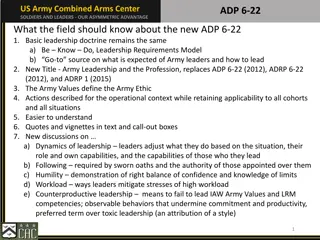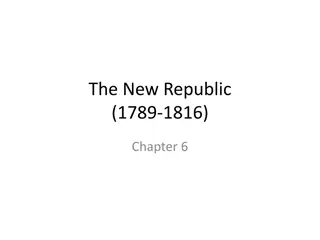George Washington's Leadership in the Revolutionary War
George Washington's leadership during the Revolutionary War was marked by bravery, strategic retreats, and pivotal victories that shaped the outcome of the conflict. Despite initial challenges, Washington's determination and military acumen played a crucial role in securing eventual success for the American forces against the British.
Download Presentation

Please find below an Image/Link to download the presentation.
The content on the website is provided AS IS for your information and personal use only. It may not be sold, licensed, or shared on other websites without obtaining consent from the author.If you encounter any issues during the download, it is possible that the publisher has removed the file from their server.
You are allowed to download the files provided on this website for personal or commercial use, subject to the condition that they are used lawfully. All files are the property of their respective owners.
The content on the website is provided AS IS for your information and personal use only. It may not be sold, licensed, or shared on other websites without obtaining consent from the author.
E N D
Presentation Transcript
George Washington's Leadership The American Battlefield Trust
Origins of the War The "Shot heard round the world" is fired at Concord beginning the Revolutionary War on April 19, 1775. Boosted by victories at Lexington & Concord, Fort Ticonderoga, and a resilient stand at Bunker Hill despite defeat, the Continental Congress formed the Continental Army under George Washington's leadership. Did You Know? Artillery is a term for larger weapons such as cannons and mortar guns. Aided by patriot Henry Knox and artillery from Fort Ticonderoga, Washington forces Britain out of Boston securing an early victory for the patriot cause. This victory is the beginning of a long and brutal war. Don Troiani
Inquiry Question: How Did George Washington's Leadership Shape the Revolutionary War?
George Washington Humble leader that valued advice from his officers. Experienced military officer before Revolutionary War (French and Indian War). Fearless in battle. Had an "unwillingness to depart" from his wife and used "every endeavor" to avoid being appointed leader of the Continental Army. Driven by a profound sense of "destiny," he accepted the position, solidifying his role as the future "Father of His Country."
"All of London is Afloat" Following the patriots' victory in Boston, Britain returned to America with vengeance (132 ships) docking in Long Island, New York under the command of William Howe (depicted). Howe achieved a decisive victory over Washington's troops at the Battle of Brooklyn and later forced them to retreat from Harlem Heights. Did You Know? A retreat is when soldiers withdraw from a battle or enemy territory to protect themselves and reassess their strategy. Washington, after numerous difficult defeats, withdrew to Pennsylvania with his weary soldiers in December 1776.
Courage in the Face of Defeat During the New York Campaign, Washington exhibited remarkable courage and maneuvered his troops in strategic retreats, preserving the spirit of freedom. His ability to evade potentially war-ending battles was a key ingredient in America ultimately winning the war. Amidst his retreat into Pennsylvania, Washington's leadership emerged as he embarked on one of the most pivotal campaigns in the Revolution, famously known as the "Ten Crucial Days." Don Troiani
Victory or Death With morale running low, Washington recognized the need to make a bold offensive move to alter the course of the war. On Christmas night 1776, Washington decided to cross the icy Delaware River back into New Jersey and launch a surprise attack on Hessian soldiers stationed at Trenton under the command of Colonel Rall. Did You Know? Hessians were professional soldiers from the German land of Hesse hired by the British to fight in America. As temperatures plummeted below freezing during the river crossing, Washington's leadership shone through as he encouraged his men in "a deep and solemn voice." Painting by Emanual Leutze
Trenton After a long trek through the night, the Continental Army attacked Trenton at 8:00 am with Washington ordering, "Advance and charge!" Washington, along with Nathanael Greene and John Sullivan, led the attack on Trenton from nearly every side of the garrison. Did You Know? A garrison is a group of soldiers stationed at a military post. The Hessians were overwhelmed as Colonel Rall attempted to execute a counterattack but was quickly and decisively defeated by Washington. Don Troiani
Assunpink Creek (Second Battle at Trenton) Washington withdrew his men following his victory at Trenton back across the Delaware. British troops under the command of Charles Cornwallis (pictured) attacked and pushed patriots back into Trenton and to the Assunpink Bridge where Washington resiliently and fiercely fought and repelled British efforts. The skirmish ended leaving Cornwallis frustrated as he had no choice but to wait until the next morning, eagerly believing it would finally be his opportunity to "bag" the "Old Fox (Washington)."
Princeton With Cornwallis prepared to attack in the morning and end the patriots fight once and for all, Washington executed another daring and impressive maneuver. Did You Know? A flank is to move around and gain the side of an enemy position, avoiding a frontal assault. He quietly flanked Cornwallis and attacked a strong British stronghold at Princeton. The battle resulted in a patriot victory officially ending the Ten Crucial Days that entirely shifted the momentum of the war. Don Troiani
Less than a year after the results of the Ten Crucial Days, Washington and the Continental Army suffered setbacks, including losses at the Battle of Brandywine and the Battle of Paoli, as well as the surrender of Fort Mifflin and Mercer to British forces. General William Howe utilized this momentum to capture Philadelphia, the largest city in America. Washington attempted to recapture Philadelphia in the Battle of Germantown but was unsuccessful forcing him to retreat to a location nearly 20 miles away called Valley Forge. Chaos in Philadelphia
Valley Forge Washington exhibited his leadership and was able to turn the British capture of Philadelphia to his favor. With the help of men such as Baron von Steuben, Marquis de Lafayette, and Alexander Hamilton, Washington utilized Valley Forge as a place to regroup and train his soldiers. Despite the significant loss of life due to the harsh winter, the time spent at Valley Forge turned out to be largely successful as a result of the training and regrouping endeavors that took place.


![❤[PDF]⚡ Civil War Talks: Further Reminiscences of George S. Bernard and His Fel](/thumb/20551/pdf-civil-war-talks-further-reminiscences-of-george-s-bernard-and-his-fel.jpg)




















